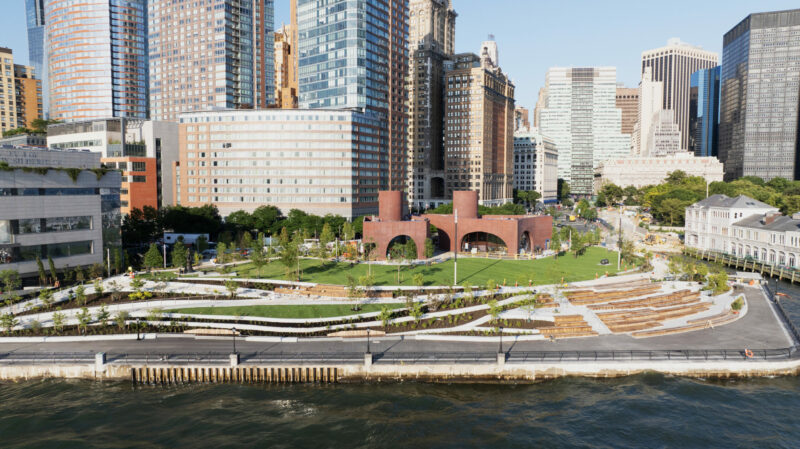-
Plan Your Visit
Attend a Free Event
Wander Wagner Guide
Coming soon!
Plan Your Visit
Attend a Free Event
Wander Wagner Guide
Coming soon!
Plan Your Visit
Attend a Free Event
Wander Wagner Guide
Coming soon!
LOADING RESULTS...Copyright © 2026 BPCA / Site created by Revolver Studios
Wagner Park: A Reimagined Resilient Waterfront Destination

Originally opened in 1996, Wagner Park has served as a cherished green space in Lower Manhattan, spanning from Battery Place and 1st Place to the northern edge of The Battery, offering stunning views of New York Harbor and the Statue of Liberty.
Named in honor of Robert F. Wagner, Jr., a dedicated public servant and key figure in the development of Battery Park City’s 1979 Master Plan, Wagner Park now embodies his legacy through innovation, resilience, and public service.
In 2023, the park closed for a major reconstruction aimed at addressing urgent climate resilience needs. This transformation was driven by the increasing threat of severe storms, such as Superstorm Sandy in 2012, which caused millions of dollars in damage to Battery Park City and cost the lives of 44 New Yorkers. The new Wagner Park integrates flood protection and sustainable infrastructure to safeguard Battery Park City and Lower Manhattan and is part of the City of New York’s Lower Manhattan Coastal Resiliency Project.

At the heart of the redesigned park is a comprehensive flood risk reduction system. Featuring both passive and deployable measures, the park will provide immediate risk reduction for a 100-year storm — a severe storm with a 1% likelihood of happening in any given year — and it also will protect against a 100-year storm in the 2050s based on projected sea level rise, once the North/West Battery Park City Resiliency Project is constructed and a tie-in between the two projects is created. The park also includes an upgraded stormwater drainage system designed to manage and reuse rainwater efficiently.


Key Features of the new Wagner Park:
-
- Integrated Flood Barrier System: Built into the landscape to protect against storm surges and sea level rise.
-
- Stormwater Management: Grading and layout direct overland flows into a system that maximizes water capture and reuse.
-
- Sustainable Materials: Salvaged stone, wood, and trench drains from the original park have been reused in construction.
-
- Urban Heat Reduction: Paving materials selected to improve the solar reflectance index (SRI) and minimize heat island effects.
-
- Dark Sky-Compliant Lighting: Energy-efficient, solar-powered lighting enhances nighttime views while reducing glare.
-
- Ecological Zones: The park includes four planted regional ecosystems—tidal estuary, maritime meadow, maritime forest, and upland woodland.
-
- Native Plantings: Designed to reduce water use, lower maintenance, and support local biodiversity.
-
- Efficient Irrigation: Subsurface systems reduce turfgrass water consumption by over 30%.
-
- Educational Marine Habitat: A new area at the Pier A inlet promotes marine growth, in addition to allowing for environmental education and marine awareness.
The park is a WEDG-verified project, meeting the Waterfront Alliance’s gold standard for resiliency, ecological, and accessible waterfront design.


The Wagner Park Pavilion, a central feature of the new park, will open in phases—with a classroom debuting in Fall 2025 and a new dining venue launching in 2026. Pursuing ILFI Zero Carbon Certification, the Pavilion is fully electrified and free of on-site combustion, setting a high bar for sustainable design. The building also features public restrooms and a publicly-accessible rooftop with stunning harbor views.
Wagner Park will continue to be a vibrant public gathering space, featuring world-class public art and free community programming for residents and visitors of all ages. In addition to hosting temporary artworks, each of which will introduce a new perspective and experience for visitors, Wagner will be the permanent home for three major sculptures. Resonating Bodies, by Tony Cragg, invites visitors to run their hands over monumental and highly textured bronze instruments. Louise Bourgeois’s Eyes look towards the Statue of Liberty, gazing with the public at New York City’s storied past. Mother Cabrini Memorial, by Jill Burkee and Giancarlo Biagi, likewise transports visitors to a shared history while being anchored by the sound of the Hudson River’s waves.

Resonating Bodies by Tony Cragg
Want to learn even more about the new Wagner Park? See the South Battery Park City Resiliency Project Design Compendium.